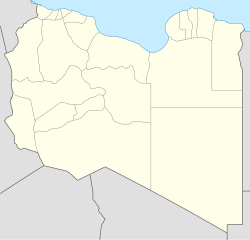Darnis
|
Derna درنة |
|
|---|---|
 |
|
| Location in Libya | |
| Coordinates: 32°46′N 22°38′E / 32.767°N 22.633°E | |
| Country |
|
| Region | Cyrenaica |
| District | Derna |
| Occupation |
|
| Population (2011) | |
| • Total | 100,000-150,000 |
| Time zone | EET (UTC+2) |
Derna /ˈdɜːrnə/ (Arabic: درنة Darnah) is a port city in eastern Libya. It has a population of 100,000–150,000. It was the seat of one of the wealthiest provinces in the Barbary States, and remains the capital of the Derna District, with a much smaller area. Derna has a unique environment among Libyan cities, as it lies between green mountains, the Mediterranean Sea, and the desert. The city is also home to people of mixed origins.
The city was also the location of the famous Battle of Derna (1805), the first victory achieved by the United States Military on foreign soil. Occurring during the First Barbary War, the battle was fought between a force of roughly 500 US Marines and Mediterranean mercenaries and four or five thousand Barbary troops.
Parts of the city were taken over by Islamic State of Iraq and the Levant (ISIL) militants in October 2014. In June 2015 Shura Council of Mujahideen in Derna defeated ISIL and took control over the town.
Darnis and Darne were the Greek forms of the name for the city. While the form Dardanis is sometimes found, it is erroneous. Under Rome the city was referred to as Darnis and Derna. Under Islam, it was known as Derneh (Derne, Dernah) or Terneh (Ternah).
In the Hellenistic period the ancient city of Darnis was part of the Libyan Pentapolis. Under Rome, it became a civil and later the religious metropolis of the province of Libya Secunda, or Libya Inferior, that is, the Marmarica region. The names of some of its metropolitan bishops are found in extant documents. Piso was one of the Eastern bishops who withdrew from the Council of Sardica and set up their own council at Philippopolis in 347. Early 5th-century Dioscorus is known because of a dispute he had with the bishop of Erythrum. Daniel took part in the Council of Ephesus in 431. In addition, John Moschus speaks of a bishop Thedodorus of Darnis as having had a vision of Saint Leo the Great in the mid-5th century.
...
Wikipedia

